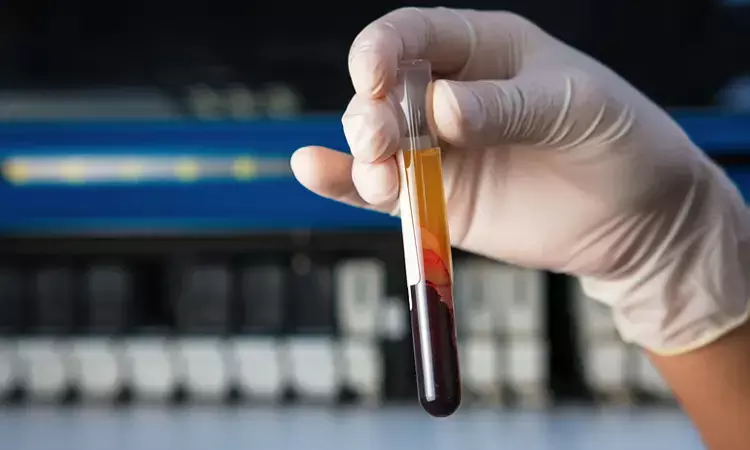- Home
- Medical news & Guidelines
- Anesthesiology
- Cardiology and CTVS
- Critical Care
- Dentistry
- Dermatology
- Diabetes and Endocrinology
- ENT
- Gastroenterology
- Medicine
- Nephrology
- Neurology
- Obstretics-Gynaecology
- Oncology
- Ophthalmology
- Orthopaedics
- Pediatrics-Neonatology
- Psychiatry
- Pulmonology
- Radiology
- Surgery
- Urology
- Laboratory Medicine
- Diet
- Nursing
- Paramedical
- Physiotherapy
- Health news
- Fact Check
- Bone Health Fact Check
- Brain Health Fact Check
- Cancer Related Fact Check
- Child Care Fact Check
- Dental and oral health fact check
- Diabetes and metabolic health fact check
- Diet and Nutrition Fact Check
- Eye and ENT Care Fact Check
- Fitness fact check
- Gut health fact check
- Heart health fact check
- Kidney health fact check
- Medical education fact check
- Men's health fact check
- Respiratory fact check
- Skin and hair care fact check
- Vaccine and Immunization fact check
- Women's health fact check
- AYUSH
- State News
- Andaman and Nicobar Islands
- Andhra Pradesh
- Arunachal Pradesh
- Assam
- Bihar
- Chandigarh
- Chattisgarh
- Dadra and Nagar Haveli
- Daman and Diu
- Delhi
- Goa
- Gujarat
- Haryana
- Himachal Pradesh
- Jammu & Kashmir
- Jharkhand
- Karnataka
- Kerala
- Ladakh
- Lakshadweep
- Madhya Pradesh
- Maharashtra
- Manipur
- Meghalaya
- Mizoram
- Nagaland
- Odisha
- Puducherry
- Punjab
- Rajasthan
- Sikkim
- Tamil Nadu
- Telangana
- Tripura
- Uttar Pradesh
- Uttrakhand
- West Bengal
- Medical Education
- Industry
Lipid Disorder Screening in Asymptomatic Children and Adolescents not recommended: USPSTF

USA: In a recent statement published in JAMA, the United States Preventive Services Task Force (USPSTF) has upheld its previous stance, stating that there is insufficient evidence to support routine screening for lipid disorders in asymptomatic children and adolescents.
The USPSTF's latest evidence review, conducted by Janelle M. Guirguis-Blake, MD, and colleagues, reaffirms their 2016 position that the balance of benefits and harms of lipid disorder screening in children and adolescents aged 20 years or younger cannot be adequately assessed. This conclusion is consistent with the 2007 statement on the same topic.
• The review highlights the prevalence of familial hypercholesterolemia (FH), a condition linked to early myocardial infarction, stroke, and death, occurring in approximately 1 in 250-500 children.
• Multifactorial dyslipidemia is more common, affecting 7.1% to 9.4% of children and adolescents.
• The task force aimed to determine whether screening for these disorders and subsequent treatment could improve health outcomes.
However, the review found no direct evidence on the benefits or harms of lipid screening in pediatric populations. While statins have been shown to reduce lipid levels in children with FH, there was no evidence that treatment is effective for multifactorial dyslipidemia. The study emphasized that FH is relatively rare, whereas multifactorial dyslipidemia is more prevalent, and the long-term benefits of treatment for FH appear to be supported by observational studies.
• The USPSTF emphasized that their "I" statement does not recommend for or against lipid disorder screening in asymptomatic children and adolescents, but instead calls for further research.
• The reviewers analyzed 43 studies encompassing 491,516 individuals under the age of 20, but none directly addressed the effectiveness and potential harms of pediatric lipid screening.
• While statins were found to lower cholesterol levels in FH patients, no single drug's efficacy was evaluated, and the duration of the trials was insufficient to assess the risk-to-benefit ratio.
• Similarly, lipid-lowering medications for multifactorial dyslipidemia showed no evidence of benefiting children.
Li Li, MD, PhD, MPH, a USPSTF member, stressed the need for additional research in four key areas. Current studies have not demonstrated the long-term benefits of early lipid-lowering treatment, nor have they assessed the long-term harms and adverse events. Furthermore, the optimal age to start lipid-lowering therapy remains unclear, and screening tests developed for adults may not be sensitive enough to detect lipid disorders in children and adolescents.
Despite the USPSTF's cautious position, other professional bodies, including the National Heart, Lung, and Blood Institute's Expert Panel, the American Academy of Pediatrics' Bright Futures program, and the multisociety Guideline on the Management of Blood Cholesterol, recommend selective or universal screening for lipid disorders in children and adolescents based on family history and risk factors.
The accompanying editorial by Sarah D. de Ferranti, MD, MPH, and colleagues supports the need for innovative study designs to fill the research gap and suggests relying on existing guidelines for clinicians' decision-making. They predict that future adoption of universal screening for FH to reduce premature cardiovascular disease burden is likely, but until then, clinicians can consider existing guidelines and discuss with pediatric patients and their families whether screening for lipid disorders is appropriate.
Reference:
US Preventive Services Task Force. Screening for lipid disorders in children and adolescents. USPSTF recommendation statement. JAMA. 2023;330(3):253-260.
Guirguis-Blake JM, Evans CV, Coppola EL, et al. Screening for lipid disorders in children and adolescents. Updated evidence report and systematic review for the USPSTF. JAMA. 2023;330(3):261-274.
Dr Kamal Kant Kohli-MBBS, DTCD- a chest specialist with more than 30 years of practice and a flair for writing clinical articles, Dr Kamal Kant Kohli joined Medical Dialogues as a Chief Editor of Medical News. Besides writing articles, as an editor, he proofreads and verifies all the medical content published on Medical Dialogues including those coming from journals, studies,medical conferences,guidelines etc. Email: drkohli@medicaldialogues.in. Contact no. 011-43720751


